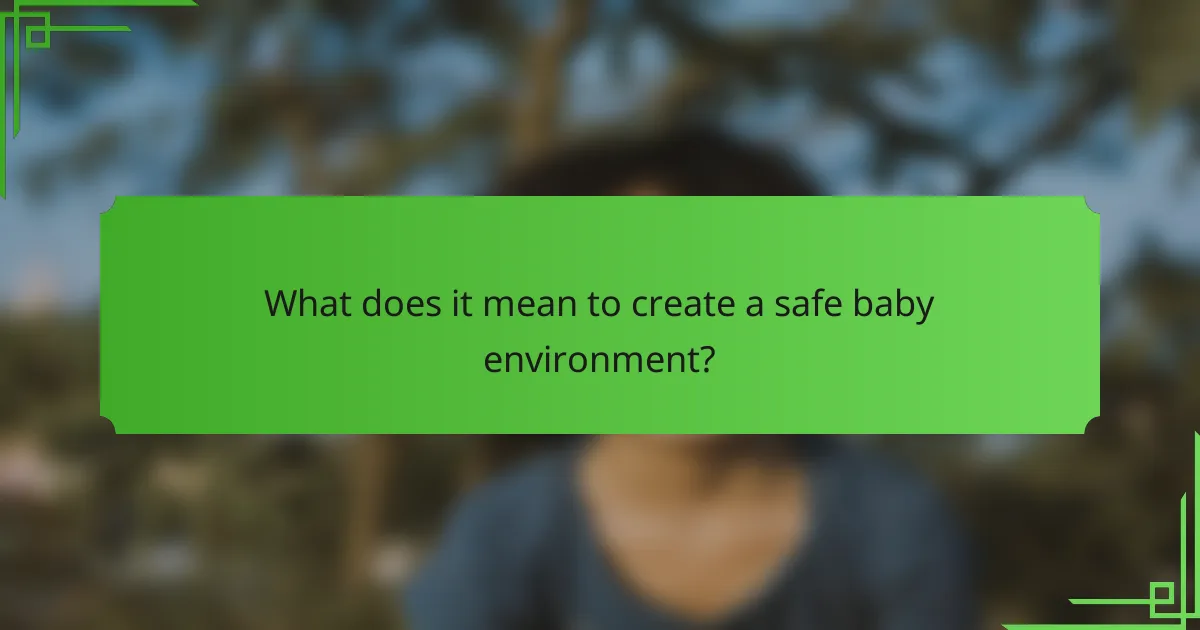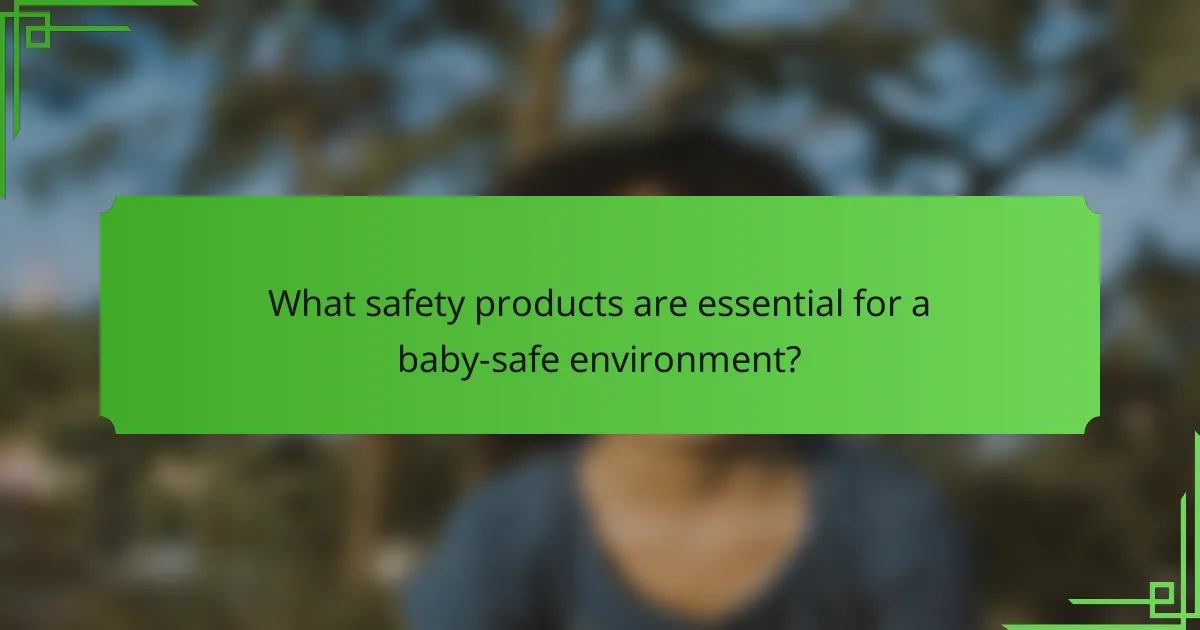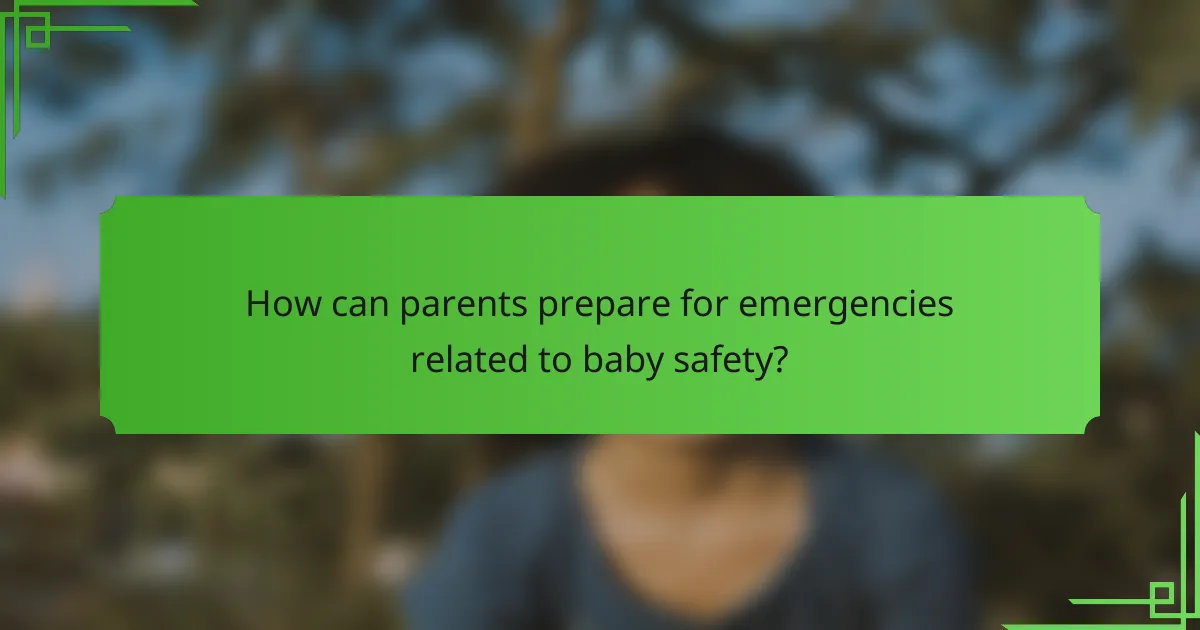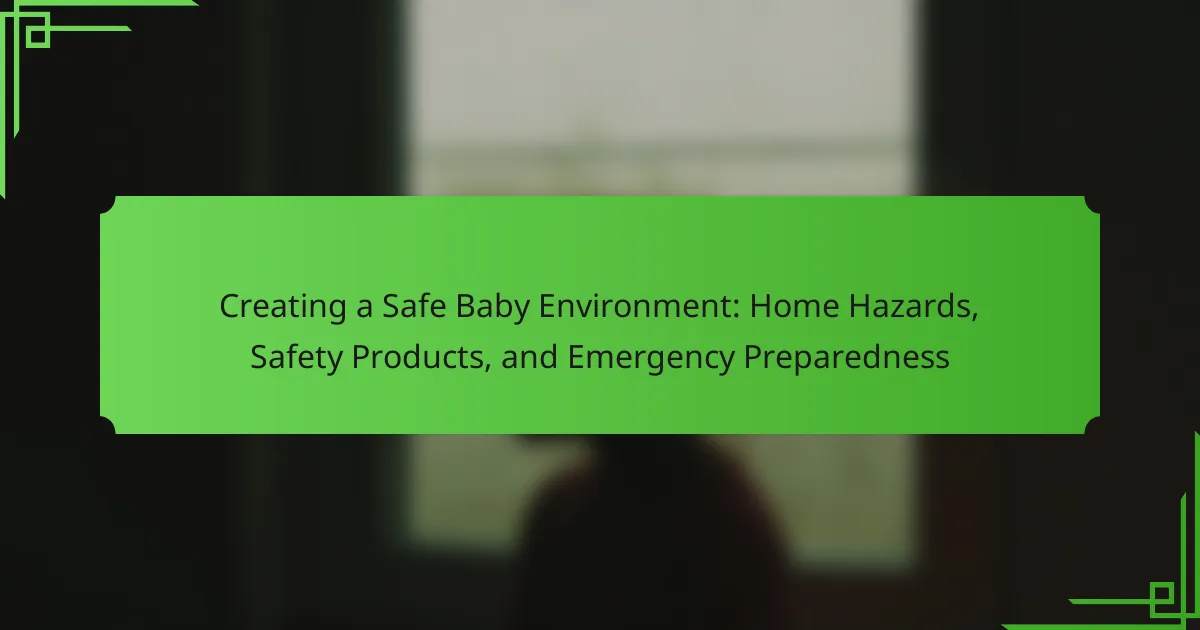Creating a safe baby environment involves ensuring that infants are protected from potential hazards within the home. Key safety products include baby gates, outlet covers, corner protectors, and cabinet locks, which collectively minimize risks associated with falls, electrical hazards, and access to harmful substances. Regular inspections of the environment are essential as the baby grows, along with a comprehensive emergency preparedness plan that includes contact information for pediatricians, a first aid kit, and practice scenarios for emergencies. Research indicates that effective childproofing significantly reduces the likelihood of injuries, underscoring the importance of maintaining a secure space for infants.

What does it mean to create a safe baby environment?
Creating a safe baby environment means ensuring a space that protects infants from potential hazards. This involves removing dangerous objects and substances within reach. It also includes using safety products like baby gates and outlet covers. Parents should regularly inspect the environment for new risks as the baby grows. Additionally, emergency preparedness is crucial. Having a plan for potential accidents can enhance safety. Studies show that childproofing reduces injury risks significantly. For instance, the American Academy of Pediatrics emphasizes the importance of creating a secure space for infants.
Why is a safe environment crucial for babies?
A safe environment is crucial for babies because it protects them from potential hazards. Babies are naturally curious and explore their surroundings. This exploration can lead to accidents if the environment is not safe. For instance, unprotected stairs can result in falls. Poisonous substances within reach can cause serious health issues. According to the American Academy of Pediatrics, home injuries are a leading cause of hospitalization for children under age five. Ensuring safety measures, such as baby gates and outlet covers, significantly reduces these risks. Therefore, a safe environment is essential for a baby’s well-being and development.
What are the potential risks in a baby’s environment?
Potential risks in a baby’s environment include choking hazards, toxic substances, and suffocation risks. Choking hazards can come from small toys, food items, or household objects. Toxic substances may include cleaning products, medications, and plants that are poisonous. Suffocation risks often arise from loose bedding, soft toys, or improper sleeping positions. Falls can occur from elevated surfaces like changing tables or couches. Electrical hazards include exposed wires and unprotected outlets. Each of these risks can lead to serious injury or health issues for infants. Ensuring a safe environment involves identifying and mitigating these risks effectively.
How can a safe environment promote a baby’s development?
A safe environment promotes a baby’s development by providing security and reducing stress. When babies feel secure, they can explore their surroundings freely. This exploration fosters cognitive and physical growth. Research indicates that a safe space encourages social interactions. Babies are more likely to engage with caregivers in a secure setting. Additionally, a hazard-free environment minimizes the risk of injury. This allows parents to focus on nurturing and teaching. Studies show that children in safe environments exhibit better emotional regulation. Overall, safety is foundational for healthy development in babies.
What are common home hazards for babies?
Common home hazards for babies include choking hazards, sharp objects, and toxic substances. Choking hazards can be small toys, food items, or household objects. Sharp objects like knives and scissors can cause serious injuries. Toxic substances include cleaning supplies and medications that should be out of reach. Electrical outlets pose risks of shock or burns if not covered. Stairs and uneven surfaces can lead to falls. Unsecured furniture can tip over, posing additional dangers. According to the American Academy of Pediatrics, baby-proofing the home reduces the risk of injury significantly.
What types of hazards are found in different rooms of the house?
Hazards in different rooms of the house include various risks that can affect safety. In the kitchen, sharp objects, hot surfaces, and slippery floors are common hazards. The bathroom often contains wet surfaces, electrical appliances near water, and toxic cleaning supplies. In the living room, tripping hazards such as loose rugs and cords can pose risks. Bedrooms may have hazards like heavy furniture that can tip over and choking hazards from small items. The basement can present risks such as mold, poor ventilation, and potential flooding. Each room has unique hazards that require specific safety measures to mitigate risks effectively.
How can household items pose risks to babies?
Household items can pose risks to babies through choking hazards, poisoning, and injury. Small objects like coins or buttons can easily be swallowed. Cleaning products often contain toxic chemicals that can be harmful if ingested. Sharp objects like scissors or knives can cause cuts or puncture wounds. Furniture can tip over, leading to crushing injuries. Electrical cords can pose strangulation risks. Additionally, certain plants are toxic if ingested. The U.S. Consumer Product Safety Commission reported thousands of injuries related to household items each year. Parents should be vigilant in identifying and mitigating these risks to ensure a safe environment for their babies.
How can parents identify and mitigate these hazards?
Parents can identify and mitigate home hazards by conducting regular safety checks. They should inspect the home for sharp objects, choking hazards, and toxic substances. Using safety gates can prevent access to dangerous areas. Parents should also secure heavy furniture to walls to prevent tipping. Installing outlet covers protects children from electrical shocks. Keeping small items out of reach reduces choking risks. Educating children about safety can further enhance their awareness. Regularly reviewing safety guidelines ensures a safe environment for children.
What steps should be taken to baby-proof a home?
To baby-proof a home, secure heavy furniture to walls. This prevents tipping during play. Install safety gates at stairs to block access. Use outlet covers to prevent electrical shocks. Keep small objects out of reach to avoid choking hazards. Store cleaning supplies in locked cabinets for safety. Use corner guards on sharp furniture edges to reduce injury risk. Ensure windows have locks or guards to prevent falls. Regularly check for hazards as the baby grows.
How often should parents reassess their home’s safety?
Parents should reassess their home’s safety at least once every six months. This regular evaluation helps identify new hazards as children grow and explore. Changes in a child’s mobility or behavior can introduce new risks. Additionally, seasonal changes may require adjustments to safety measures. For example, winter may necessitate checking heating sources. Regular reassessment ensures that safety products remain effective. Experts recommend documenting safety checks to track changes over time. This practice promotes a proactive approach to child safety at home.

What safety products are essential for a baby-safe environment?
Essential safety products for a baby-safe environment include baby gates, outlet covers, and corner protectors. Baby gates prevent access to stairs and hazardous areas. Outlet covers protect curious fingers from electrical outlets. Corner protectors cushion sharp furniture edges. Cabinet locks secure harmful substances from children. Non-slip mats reduce the risk of falls in bathrooms. Safety harnesses in high chairs and strollers ensure secure seating. These products collectively minimize risks and enhance safety for infants.
What types of safety products should parents consider?
Parents should consider several types of safety products to ensure a secure environment for their children. These include baby gates to restrict access to dangerous areas. Corner protectors can prevent injuries from sharp furniture edges. Outlet covers are essential to prevent electrical accidents. Cabinet locks keep hazardous substances out of reach. Bath mats and non-slip stickers help prevent slips in wet areas. Monitors allow parents to keep an eye on their child remotely. Smoke detectors and carbon monoxide detectors are crucial for fire safety. First aid kits should be readily available for emergencies. Each of these products plays a vital role in enhancing child safety at home.
How do baby gates enhance safety in the home?
Baby gates enhance safety in the home by preventing young children from accessing hazardous areas. They act as physical barriers that restrict movement to unsafe spaces like stairs, kitchens, or rooms with dangerous items. Baby gates are designed to be sturdy and secure, reducing the risk of falls and injuries. According to the American Academy of Pediatrics, using gates at the top and bottom of stairs is crucial for child safety. Properly installed baby gates can decrease the likelihood of accidents, providing peace of mind for parents. Their effectiveness is supported by safety standards that ensure they withstand force and are difficult for children to open.
What role do outlet covers play in preventing accidents?
Outlet covers play a crucial role in preventing accidents, particularly for young children. They protect children from electrical shock by covering unused electrical outlets. This barrier prevents children from inserting objects into the outlets, which can lead to dangerous situations. According to the National Fire Protection Association, electrical outlets are a common source of injury among toddlers. Installing outlet covers significantly reduces the risk of these accidents. Research indicates that homes with outlet covers report fewer incidents of electrical injuries in children. Therefore, using outlet covers is an effective safety measure to create a safer environment for babies and toddlers.
How can parents choose the right safety products?
Parents can choose the right safety products by assessing their home environment and identifying potential hazards. They should evaluate areas where their children play and explore. Research shows that 2.5 million children are treated for injuries related to home hazards each year. Parents should prioritize products that meet safety standards, such as those certified by organizations like ASTM or CPSC. Reading product reviews and seeking recommendations from other parents can provide valuable insights. Additionally, parents should consider the age and developmental stage of their child when selecting products. This ensures the safety products are appropriate for their specific needs. Regularly updating safety products as the child grows is also essential for ongoing safety.
What features should parents look for in safety gear?
Parents should look for durability, comfort, and proper fit in safety gear. Durability ensures the gear withstands wear and tear during use. Comfort allows children to wear the gear without fuss, promoting consistent use. Proper fit is crucial for effectiveness; gear that is too loose or tight can compromise safety. Additionally, parents should check for safety certifications, which indicate that the gear meets specific safety standards. Features like adjustable straps enhance fit and usability. Reflective materials can improve visibility in low-light conditions. Finally, ease of cleaning is important for maintaining hygiene.
How can parents ensure safety products meet regulatory standards?
Parents can ensure safety products meet regulatory standards by checking for certification labels. These labels indicate compliance with safety regulations set by organizations like the Consumer Product Safety Commission (CPSC). Parents should research the specific safety standards applicable to each product type. They can also review product recalls and safety notices from reliable sources. Consulting consumer reviews can provide insights into product safety. Additionally, purchasing products from reputable manufacturers further enhances safety assurance. Parents should stay informed about updates in safety regulations that may affect products they use.
What are some effective safety practices for using these products?
Effective safety practices for using safety products include regular inspection and maintenance. Check for wear and tear on items like baby gates and car seats. Ensure that products meet current safety standards, such as those set by the Consumer Product Safety Commission. Use products according to manufacturer guidelines for age and weight limits. Secure furniture to walls to prevent tipping hazards. Always supervise children when using safety products. Store hazardous items out of reach to prevent accidents. These practices help minimize risks and ensure a safer environment for babies.
How should safety products be installed for maximum effectiveness?
Safety products should be installed according to manufacturer guidelines for maximum effectiveness. Proper installation ensures that the products function as intended. For example, baby gates should be mounted securely to walls, not just pressure-fit. This prevents the gate from being easily knocked over. Additionally, safety latches on cabinets should be installed at a height that is inaccessible to children. This minimizes the risk of accidental access to harmful substances. Smoke detectors must be placed on every level of the home and tested monthly to ensure functionality. According to the National Fire Protection Association, working smoke detectors reduce the risk of fire-related deaths by 50%. Regularly checking and maintaining these products enhances their effectiveness in preventing accidents.
What maintenance is required for safety products over time?
Safety products require regular inspection, cleaning, and replacement over time. Inspect items like baby gates, outlet covers, and safety locks for wear and damage. Clean these products to remove dirt and grime that may affect functionality. Replace any safety product that shows signs of deterioration or has been involved in an incident. For example, safety gates should be checked monthly for secure installation. Additionally, expiration dates on certain safety products, such as car seats, should be monitored and adhered to. Regular maintenance ensures optimal protection and compliance with safety standards.

How can parents prepare for emergencies related to baby safety?
Parents can prepare for emergencies related to baby safety by creating a comprehensive emergency plan. This plan should include contact information for pediatricians and local emergency services. Parents should also have a first aid kit specifically designed for infants. Regularly checking the kit ensures that supplies are up to date. Additionally, parents should practice emergency scenarios, such as choking or fire drills, with caregivers. Keeping emergency numbers visible and accessible is crucial. Educating caregivers about baby safety protocols enhances preparedness. Lastly, parents should stay informed about recalls on baby products to avoid potential hazards.
What emergency situations should parents be prepared for?
Parents should be prepared for various emergency situations. These include medical emergencies such as choking, drowning, or severe allergic reactions. They should also prepare for household accidents like burns, falls, or poisoning. Natural disasters, including fires, floods, and earthquakes, are critical situations to consider. Additionally, parents must be ready for situations involving lost or missing children. Each of these scenarios requires specific knowledge and action plans. For example, knowing CPR can save a child’s life during a choking incident. Having a fire escape plan is essential for safety during a fire.
What are common emergencies that can occur in a baby’s environment?
Common emergencies in a baby’s environment include choking, drowning, and falls. Choking can occur from small objects or food items. Drowning risks exist in bathtubs, buckets, or pools. Falls can happen from changing tables, beds, or stairs. Burns may result from hot liquids or surfaces. Poisoning can occur from ingesting household chemicals or medications. Allergic reactions may arise from certain foods or insect stings. Each of these emergencies poses significant risks to infants and requires prompt attention.
How can parents create an emergency plan for their family?
Parents can create an emergency plan for their family by following specific steps. First, they should assess potential emergencies that could occur in their area. This includes natural disasters, fires, and medical emergencies. Next, they need to establish clear communication plans. This can involve designating a meeting place and ensuring everyone knows how to contact each other.
Additionally, parents should create an emergency kit. This kit should include essential supplies such as water, food, medications, and first aid items. Regularly reviewing and practicing the emergency plan is crucial. This ensures that all family members are familiar with the procedures.
Finally, parents should stay informed about local emergency services and resources. Understanding available support can enhance their preparedness. These steps create a comprehensive emergency plan that helps ensure family safety during crises.
What supplies should be included in an emergency kit for babies?
An emergency kit for babies should include essential supplies to ensure their safety and well-being. Key items are diapers, wipes, and a changing pad for hygiene needs. A sufficient supply of formula or breast milk is crucial for feeding. Baby food jars or pouches should also be included for older infants. A first aid kit with baby-safe items is necessary for minor injuries. Additional supplies include a thermometer, baby medications, and a soft blanket for comfort. It is important to have extra clothing and a pacifier for soothing. Finally, a flashlight and batteries are essential for power outages or emergencies. These items collectively provide comprehensive care for a baby in an emergency situation.
What essential items should be in a baby-specific emergency kit?
A baby-specific emergency kit should include essential items for health and safety. Include a first aid kit with band-aids, antiseptic wipes, and gauze. Add infant pain reliever and any prescribed medications. Include a thermometer for monitoring fever. Pack extra diapers and wipes for hygiene needs. Include a change of clothes to keep the baby comfortable. Include a flashlight with extra batteries for visibility in emergencies. Finally, add a list of emergency contacts, including pediatrician information. These items ensure preparedness for various situations involving infants.
How can parents personalize their emergency kit based on their needs?
Parents can personalize their emergency kit by assessing their family’s specific needs. They should consider the ages and health conditions of their children. Including age-appropriate items like diapers, formula, or medications is essential. Parents can also add comfort items, such as favorite toys or blankets, to ease stress. Identifying local hazards, like natural disasters, helps tailor the kit’s contents. Parents should include necessary documents, such as medical records and emergency contacts. Regularly reviewing and updating the kit ensures it remains relevant. This approach enhances preparedness and meets the unique needs of each family.
What are the best practices for emergency preparedness?
The best practices for emergency preparedness include creating a comprehensive emergency plan. This plan should outline evacuation routes and emergency contacts. Families should conduct regular drills to ensure everyone knows their roles. Additionally, assembling an emergency kit is crucial. This kit should contain essential supplies like water, food, and first aid items. Keeping important documents in a safe, accessible location is also recommended. Regularly reviewing and updating the plan ensures its effectiveness. According to the Federal Emergency Management Agency (FEMA), being prepared can significantly reduce anxiety during an emergency.
How can parents practice their emergency plan effectively?
Parents can practice their emergency plan effectively by conducting regular drills. These drills should simulate various emergency scenarios, such as fires or natural disasters. Parents should involve all family members in these drills. This ensures everyone knows their roles and responsibilities.
Parents can also review the emergency plan together as a family. Discussing the plan reinforces understanding and retention. Additionally, they should update the plan as needed, considering changes in circumstances.
Research shows that families who practice emergency plans are better prepared. A study from the National Fire Protection Association indicates that practicing drills improves response times during actual emergencies.
What resources are available for parents to learn more about baby safety?
Parents can access various resources to learn about baby safety. The American Academy of Pediatrics (AAP) provides guidelines and safety tips on their website. The Centers for Disease Control and Prevention (CDC) offers information on preventing injuries in infants. Books on baby care and safety are available from reputable publishers. Local hospitals often conduct parenting classes that include safety education. Online courses and webinars are also offered by organizations focused on child health. Additionally, parenting forums and support groups can share personal experiences and safety advice.
What are the top tips for maintaining a safe baby environment?
Ensure the baby environment is free from hazards. Remove sharp objects and choking hazards from reach. Use safety gates to block stairs and dangerous areas. Secure heavy furniture to walls to prevent tipping. Install outlet covers to protect from electrical shocks. Keep cleaning supplies and medications locked away. Use non-toxic materials for toys and furniture. Regularly check for potential dangers as the baby grows.
Creating a safe baby environment is essential for protecting infants from potential hazards in the home. This article covers the significance of safety measures, including identifying common home hazards such as choking risks, toxic substances, and falls. It also emphasizes the importance of safety products like baby gates and outlet covers, as well as emergency preparedness strategies for parents. By regularly assessing their home environment and utilizing appropriate safety gear, parents can significantly reduce injury risks and promote healthy development for their babies.
